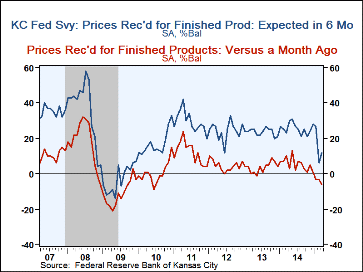 Global| Mar 26 2015
Global| Mar 26 2015Kansas City Fed's Factory Sector Index Moves Sharply Lower, Helped by Port Closings
by:Tom Moeller
|in:Economy in Brief
Summary
The Federal Reserve Bank of Kansas City reported that business activity moderated significantly this month. The Fed indicated that answers to a special question cited West Coast port disruptions as contributing significantly to the [...]
The Federal Reserve Bank of Kansas City reported that business activity moderated significantly this month. The Fed indicated that answers to a special question cited West Coast port disruptions as contributing significantly to the weakening. The Composite index of 10th District factory sector activity fell to -4 this month, the lowest level since June 2013. A negative new orders figure of -20 accounted for much of the deterioration as it plunged to the lowest level since February 2013. The shipments index hit zero, down from 15 one year ago. The employment reading improved slightly to -2 but remained near the recent lows. The composite index is an average of the production, new orders, employment, supplier delivery time and materials inventory indexes. The prices received index deteriorated m/m to -6, the lowest level since June 2010. The index of prices paid for raw materials collapsed to -12, the lowest point since May 2009.
The expectations reading deteriorated significantly to 4, the lowest level since April 2013; yet it remained positive, suggesting future improvement in business conditions. Expected new orders plunged to a recovery low of 6 while the expected shipments figure fell moderately to 20, the lowest point since October 2013. The expected employment reading also plunged to its weakest reading since October 2013. The employee workweek reading also fell to its lowest since October. Expected capital expenditures extended recent declines as they fell to the lowest point since August 2010. Expected pricing power for finished products notched up m/m but remained near five-year lows. Expected raw materials prices slipped to nearly the lowest level of the economic recovery.
The diffusion indexes are calculated as the percentage of total respondents reporting increases minus the percentage reporting declines. The survey included 94 responses from plants in Colorado, Kansas, Nebraska, Oklahoma, Wyoming northern New Mexico. Data for the Kansas City Fed Survey can be found in Haver's SURVEYS database.
| Kansas City Federal Reserve Manufacturing Survey (SA) | Mar | Feb | Jan | Mar '14 | 2014 | 2013 | 2012 |
|---|---|---|---|---|---|---|---|
| Conditions Versus One Month Ago (% Balance) | -4 | 1 | 3 | 10 | 6 | 0 | 4 |
| New Orders Volume | -20 | -10 | -8 | 12 | 8 | 1 | 0 |
| Number of Employees | -2 | -4 | 0 | 4 | 5 | -2 | 5 |
| Prices Received for Finished Product | -6 | -3 | -3 | 10 | 5 | 4 | 5 |
| Expected Conditions in Six Months | 4 | 11 | 19 | 11 | 17 | 10 | 12 |
| New Orders Volume | 6 | 15 | 24 | 28 | 26 | 18 | 21 |
| Number of Employees | 7 | 14 | 2 | 29 | 18 | 9 | 13 |
| Prices Received for Finished Product | 12 | 6 | 27 | 23 | 26 | 24 | 24 |
Tom Moeller
AuthorMore in Author Profile »Prior to joining Haver Analytics in 2000, Mr. Moeller worked as the Economist at Chancellor Capital Management from 1985 to 1999. There, he developed comprehensive economic forecasts and interpreted economic data for equity and fixed income portfolio managers. Also at Chancellor, Mr. Moeller worked as an equity analyst and was responsible for researching and rating companies in the economically sensitive automobile and housing industries for investment in Chancellor’s equity portfolio. Prior to joining Chancellor, Mr. Moeller was an Economist at Citibank from 1979 to 1984. He also analyzed pricing behavior in the metals industry for the Council on Wage and Price Stability in Washington, D.C. In 1999, Mr. Moeller received the award for most accurate forecast from the Forecasters' Club of New York. From 1990 to 1992 he was President of the New York Association for Business Economists. Mr. Moeller earned an M.B.A. in Finance from Fordham University, where he graduated in 1987. He holds a Bachelor of Arts in Economics from George Washington University.










